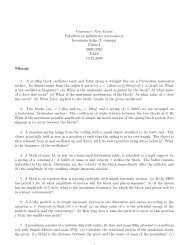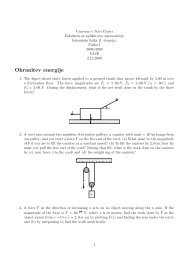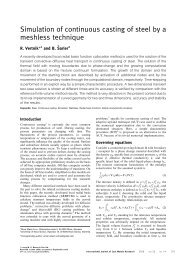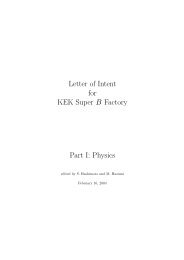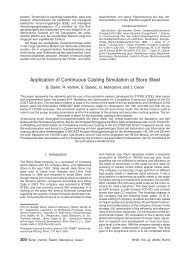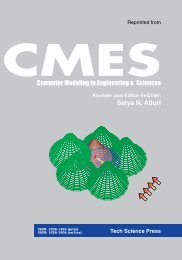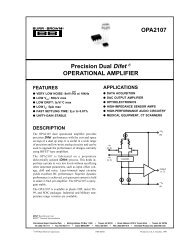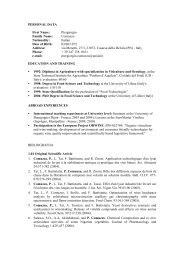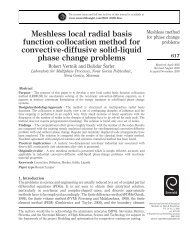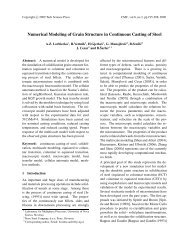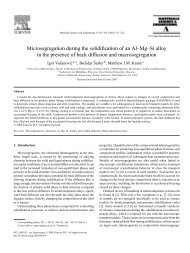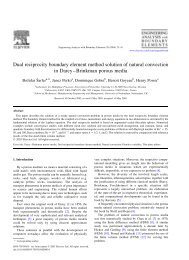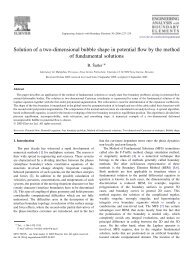Letter of Intent for KEK Super B Factory Part I: Physics
Letter of Intent for KEK Super B Factory Part I: Physics
Letter of Intent for KEK Super B Factory Part I: Physics
You also want an ePaper? Increase the reach of your titles
YUMPU automatically turns print PDFs into web optimized ePapers that Google loves.
Table 1.2: B → K ∗ γ branching fractions<br />
B 0 → K ∗0 γ B + → K ∗+ γ<br />
[×10 −5 ] [×10 −5 ]<br />
CLEO 4.55 ± 0.70 ± 0.34 3.76 ± 0.86 ± 0.28<br />
BaBar 4.23 ± 0.40 ± 0.22 3.83 ± 0.62 ± 0.22<br />
Belle 4.09 ± 0.21 ± 0.19 4.40 ± 0.33 ± 0.24<br />
The decay mode B → K + K − K 0 S , where K+ K − combinations consistent with the φ have<br />
been removed, is found to be dominantly CP -even [29] and thus can be treated as a CP -<br />
eigenstate and used <strong>for</strong> studies <strong>of</strong> time-dependent CP -violation in b → sqq processes. The<br />
beam constrained mass distribution <strong>for</strong> the B → K + K−K 0 S sample used by Belle is shown in<br />
Figure 1.3(b). There are 199 ± 18 signal events. The result is<br />
sin 2φ1eff(B → K + K − K 0 S) = 0.51 ± 0.26 ± 0.05 +0.18<br />
−0.00 , (1.5)<br />
where the third error is due to the uncertainty in the CP content <strong>of</strong> this final state [29]. The<br />
results <strong>for</strong> B → K + K−K 0 S are also consistent with b → ccs decays. However, in this decay there<br />
is also the possibility <strong>of</strong> “tree-pollution”, i.e. the contribution <strong>of</strong> a b → uus tree amplitude that<br />
may complicate the interpretation <strong>of</strong> the results [27].<br />
The mode B → η ′ K0 S is expected to include contributions from b → suu and b → sdd<br />
penguin processes. The beam constrained mass distribution <strong>for</strong> the B → η ′ K0 S sample is shown<br />
in Figure 1.3(c) and contains 244 ± 21 signal events [30]. The fit gives (Figure 1.4(e,f)),<br />
sin 2φ1eff(B → η ′ K 0 S) = 0.43 ± 0.27 ± 0.05. (1.6)<br />
The average with the BaBar result (0.02 ± 0.34 ± 0.03 with 82 fb −1 ) [31] is about 2.2σ from the<br />
b → ccs measurement, which is the Standard Model expectation.<br />
1.2.3 Radiative B decays<br />
Exclusive B → K ∗ γ<br />
Measurement <strong>of</strong> the B → K ∗ γ exclusive branching fraction is straight<strong>for</strong>ward, since one can use<br />
Mbc, ∆E and K ∗ mass constraints. (K ∗ denotes K ∗ (892) throughout this section.) The latest<br />
Belle measurement (Figure 1.5) uses 78 fb −1 <strong>of</strong> data, with a total error <strong>of</strong> much less than 10%<br />
<strong>for</strong> each <strong>of</strong> the B 0 and B + decays. The results from CLEO [32], BaBar [33] and Belle [34] are<br />
in good agreement and are listed in Table 1.2. The world averages are calculated as<br />
B(B 0 → K ∗0 γ) = (4.17 ± 0.23) × 10 −5 , (1.7)<br />
B(B + → K ∗+ γ) = (4.18 ± 0.32) × 10 −5 . (1.8)<br />
The corresponding theoretically predicted branching fraction is about (7±2)×10−5 , higher than<br />
the measurement with a large uncertainty [35, 36]. A better approach to exploit the B → K∗γ branching fraction measurements is to consider isospin asymmetry [37]. A small difference in the<br />
branching fractions between B0 → K∗0γ and B + → K∗+ γ tells us the sign <strong>of</strong> the combination<br />
<strong>of</strong> the Wilson coefficients, C6/C7. Belle has taken into account correlated systematic errors and<br />
obtains<br />
∆+0 ≡ (τB +/τB0)B(B0 → K∗0γ) − B(B + → K∗+ γ)<br />
(τB +/τB0)B(B 0 → K∗0γ) + B(B + → K∗+ γ)<br />
(1.9)<br />
= (+0.003 ± 0.045 ± 0.018),<br />
15



